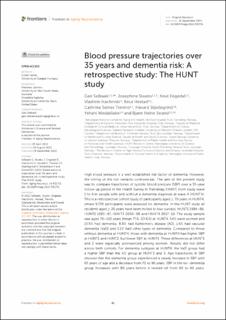Blood pressure trajectories over 35 years and dementia risk: A retrospective study: The HUNT study
Selbæk, Geir; Stuebs, Josephine; Engedal, Knut; Hachinski, Vladimir; Hestad, Knut; Treviño, Cathrine Selnes; Skjellegrind, Håvard; Wedatilake, Yehani; Strand, Bjørn Heine
Peer reviewed, Journal article
Published version
Permanent lenke
https://hdl.handle.net/11250/3023540Utgivelsesdato
2022-09-15Metadata
Vis full innførselSamlinger
Originalversjon
10.3389/fnagi.2022.931715Sammendrag
High blood pressure is a well-established risk factor of dementia. However, the timing of the risk remains controversial. The aim of the present study was to compare trajectories of systolic blood pressure (SBP) over a 35-year follow-up period in the Health Survey in Trøndelag (HUNT) from study wave 1 to 4 in people with and without a dementia diagnosis at wave 4 (HUNT4). This is a retrospective cohort study of participants aged ≥ 70 years in HUNT4, where 9,720 participants were assessed for dementia. In the HUNT study all residents aged ≥ 20 years have been invited to four surveys: HUNT1 1984–86, HUNT2 1995–97, HUNT3 2006–08 and HUNT4 2017–19. The study sample was aged 70–102 years (mean 77.6, SD 6.0) at HUNT4, 54% were women and 15.5% had dementia, 8.8% had Alzheimer’s disease (AD), 1.6% had vascular dementia (VaD) and 5.1% had other types of dementia. Compared to those without dementia at HUNT4, those with dementia at HUNT4 had higher SBP at HUNT1 and HUNT2, but lower SBP at HUNT4. These differences at HUNT1 and 2 were especially pronounced among women. Results did not differ across birth cohorts. For dementia subtypes at HUNT4, the VaD group had a higher SBP than the AD group at HUNT2 and 3. Age trajectories in SBP showed that the dementia group experienced a steady increase in SBP until 65 years of age and a decrease from 70 to 90 years. SBP in the no- dementia group increased until 80 years before it leveled off from 80 to 90 years. Frontiers in Aging Neuroscience. The present study confirms findings of higher midlife SBP and lower late-life SBP in people with dementia. This pattern may have several explanations and it highlights the need for close monitoring of BP treatment in older adults, with frequent reappraisal of treatment needs.

